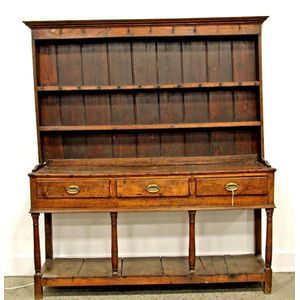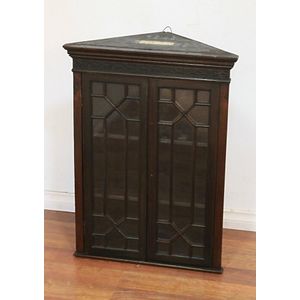Figured Walnut Marquetry Breakfront Sideboard with Inlays and Lattice Design
You must be a subscriber, and be logged in to view price and dealer details.
Subscribe Now to view actual auction price for this item
When you subscribe, you have the option of setting the currency in which to display prices to $Au, $US, $NZ or Stg.
- Breakfront - A design generally found in larger pieces of furniture, such as bookcases, wardrobes and some sideboards. The line of the front is interrupted by the middle section standing out from each end. In a reverse breakfront, the centre section is recessed behind each end. Breakfronted pieces are usually made in three sections the middle and the two wings which are held together by the cornice and pediment, and the plinth on which it stands. The sensible buyer should show caution before buying breakfront pieces, especially bookcases, which are highly desirable and expensive. Always check that the timber, colour, patination, backboards, decoration and thickness of the wood are same in each section.
- Figured - A descriptive term to describe the patterns in the grain of timber. An object may be described as "well figured" or "highly figured" if the grain on a section of the object is highly patterned, as with flame mahogany or burr walnut.
- Foliate - Decorated with leaves or leaf-like forms.
- Marquetry - In marquetry inlay, contrasting woods, and other materials such as ivory, shell and metal are inlaid either as panels or in a single continuous sheet over the surface of the piece. The design may be straightforward, such as a shell pattern or a basket of flowers, or it may be infinitely complex, with swirling tendrils of leaves, flowers and foliage, such as one finds, for example, in the "seaweed" patterns on longcase clocks of the William and Mary and Queen Anne periods.
- Bun Feet - Similar to ball feet, though somewhat compressed or flattened in appearance. Introduced during the late 17th century, but they have been used on furniture up to the present day.
This item has been included into following indexes:
Visually similar items

An early 19th century mahogany miniature chest, the grape, vine & wolf relief carved front doors opening to seven drawers. An elaborate geometric design carved to each side of the cabinet, with key. 38 x 34 x 28 cm.

An antique oak Welsh dresser comprising three drawers above an open shelf and two plate rack shelves to the upper section. Height 173 cm. Width 153 cm. Depth 40 cm

A Chippendale Revival mahogany two door miniature corner cabinet. 69 cm high, 50 cm long, 26 cm deep

A James II oak coffer, 17th century the front panel inscribed 'M.S.' above three carved gothic panels 65 cm high by 147 cm wide and 60 cm deep
